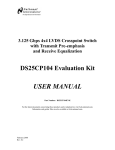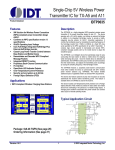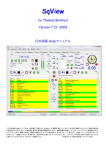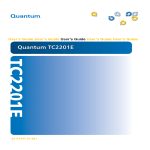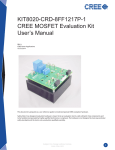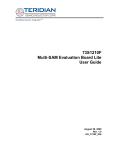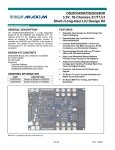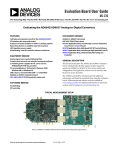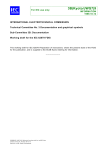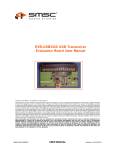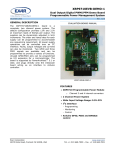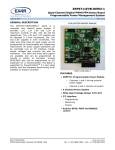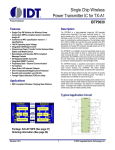Download WPC1.1-Compatible A5/A11 Wireless Power Transmitter
Transcript
WPC1.1-Compatible A5/A11 Wireless Power Transmitter Product Preview IDTP9038 Description Features The IDTP9038 is a WPC-compliant Wireless Power Transmitter for A5 and A11 designs operating from 5V supplies which conforms with WPC Specification 1.1. Operating in the WPCcompliant mode, the integrated full-bridge inverter supports 8W power transfer utilizing the IDTP902X Receiver family, and ensures efficient switching with EMI/RFI emissions that are better than the requirements of the WPC specification. An embedded microcontroller provides extensive control & application flexibility. In addition to implementing the WPCspecified device identification and a closed-loop control protocol which constantly adjusts transmitted power, the IDTP9038 features a proprietary back-channel communication mode compatible with other IDT Wireless Power products, providing secure authentication with data encryption using a Secure Hash Algorithm (SHA) of up to 64 bits. Featuring programmable multi-layer Foreign Object Detection and built-in Over-Current, Over-Voltage, and Over-Temperature Protection, the IDTP9038 is extremely easy to use and provides a complete WPC-compliant solution with minimum external parts count, requiring significantly less board space and lower total solution cost than competing products. It is available in a compact 7mm x 7mm VQFN package. A complete Evaluation kit is available with an easy-to-use GUI interface, which allows users to quickly verify system performance and implement WPC-compliant designs with minimal effort. Integrated 5V WPC 1.1-compliant Transmitter for A5 or A11-type coils Conforms with WPC Specification 1.1 Operates from 5V supplies (4.5V to 6.9V) Easy to Use, with Reduced Parts Count 8W Power Transfer Solution Integrated Full-Bridge Inverter for Optimal Coil Drive Ensures Low EMI/RFI Emissions Demodulates and Decodes Communication Packets from WPC-compliant Receivers Implements Closed-Loop Power Transfer Control Optional Proprietary Back-Channel Communication Security and Encryption up to 64-bit USB Interface Supports High Current Charging with D+ / D- detection Master/Slave I2C Interface Safety Features Over-Current, Over-Voltage, and Over-Temperature Protection Fully Integrated Programmable WPC1.1-Compliant Multilayer Foreign Object Detection (FOD) Power Good and Fault Condition Detection with LED Indicator outputs Applications Charging Mats or Pads Public Facilities – Shops, Libraries, Airports, Schools Office Furniture Personal Computer Docks Portable Instruments Wireless Interface Base Station Transmitter(s) Mobile Device Receiver Control Input Power Control System Package: 7x7-56 VFQFN (See page 22) Ordering Information: (See page 24) Version 0.8 Control System Comm Cont Sensing Control Comm DeMod Comm Load Reflection Power Generation IN PWR 1 Cont Sensing Control Mod Power Pick-Up Induction Output Load Out PWR © 2013 Integrated Device Technology, Inc. IDTP9038 Product Datasheet ABSOLUTE MAXIMUM RATINGS These absolute maximum ratings are stress ratings only. Stresses greater than those listed below (Table 1 and Table 2) may cause permanent damage to the device. Functional operation of the IDTP9038 at absolute maximum ratings is not implied. Exposure to absolute maximum rating conditions for extended periods may affect long-term reliability. Table 1. Absolute Maximum Ratings Summary. (All voltages are referred to ground.) Pins Rating Units VBUS_SNS -0.3 to 27 V -0.3 to 12.5 V -0.3 to 5.5 V -0.3 to SW+6 V -0.3 to REG_IN+6 V +0.3 V SHIELD1 -0.3 to 8 V LDO2P5V -0.3 to 2.75 V EN, IN, REG_IN, , SW1, SW2, ISNSN_IN, ISNSP_IN GPIO_6:0, SCL, SDA, RESET, DP, DM, NC, NC1, NC2, NC3, SHIELD2, LDO5V, LDO2P5V_IN, INV5V_IN, VFOD_SNS, ISNS, HPF, OVP_SEL, ISNS_V BST1, BST2 GATE GND, REFGND, PGND1, PGND2 Table 2. Package Thermal Information SYMBOL DESCRIPTION ΘJA ΘJC ΘJB TJ TA TSTG TLEAD Thermal Resistance Junction to Ambient Thermal Resistance Junction to Case Thermal Resistance Junction to Board Operating Junction Temperature Ambient Operating Temperature Storage Temperature Lead Temperature (soldering, 10s) TQFN RATING UNITS 25.5 8.6 2.4 -40 to +125 -40 to +85 -55 to +150 +300 C/W C/W C/W C C C C Note 1: The maximum power dissipation is PD(MAX) = (TJ(MAX) - TA) / θJA where TJ(MAX) is 125°C. Exceeding the maximum allowable power dissipation will result in excessive die temperature, and the device will enter thermal shutdown. Note 2: This thermal rating was calculated on JEDEC 51 standard 4-layer board with dimensions 3” x 4.5” in still air conditions. Note 3: Actual thermal resistance is affected by PCB size, solder joint quality, layer count, copper thickness, air flow, altitude, and other unlisted variables. Table 3. ESD Information TEST MODEL PINS HBM All pins. +/- 2000 V CDM All pins. +/- 500 V Version 0.8 RATINGS 2 UNITS © 2013 Integrated Device Technology, Inc. IDTP9038 Product Datasheet SPECIFICATION TABLE Table 4. Device Characteristics VIN = 5V, EN ¯¯ = 0V, CIBUS = 1μF, CBYPASS = 40μF, Coil = A5, COUT_T1 = 400nF, TA =-40 to +85C, unless otherwise noted. Typical values are at 25°C, unless otherwise noted. Symbol Description Conditions/Notes Min VBUS_MIN to OVP_Max 4.5 Typ Max Units 6.9 V 33 45 mA 8 12 mA Input Supplies & UVLO VBUS Input Operating range Operating Input Current IIN_REGIN NOTE 2 Standby Input Current (no ping) Standby Input Current (pinging) Sleep Mode Input Current IIN_VBUS_SNS VREGIN_UVLO VBUS_SNS Input Current VBUS_SNS = 6.9V REGIN Under-Voltage Protection Trip Points Rising Falling Hysteresis Full Bridge PWM Generators FSW Switching frequency Switching Frequency Step FSW LSB Size Duty Duty cycle Full Bridge Inverter Over-Current Protection Trip Point Range Over-Current Protection IHS_OCP_ACC Trip Point Accuracy Input OVP, Inrush Control, and Current Limit IHS_OCP_RNG VBUS_OVP After power-up sequence complete, No coil, 175kHz switching at SW1, SW2, LDO5V, LDO2P5V. After power-up sequence complete. No coil, no switching at SW1, SW2, LDO5V, LDO2P5V. After power-up sequence complete. Average including pinging EN ¯¯ = REG_IN = 6.9V VBUS Over-Voltage Protection Trip Point 15 mA 600 uA 1 mA 4.1 V V mV 205 kHz 3.4 150 110 12.5 VREG=4.5V-6.9V 10 VIN = 5V, cycle-by-cycle protection., programmable Range 50 ns 90 % 3 15 A VIN=5V, OCP Setting = 5A -20 20 % VBUS rising, OVP_SEL pin grounded 6.7 7.15 V VBUS rising, OVP_SEL pin 220k 5% to GND 5.8 6.3 V VBUS rising, OVP_SEL pin Floating 7.3 7.85 Hysteresis 200 V mV TGATE_RISE GATE Voltage rise time VBUS=5V, Gate cap = 4nF VGATE=1V to VIN+4V 3.6 ms DGATE_FALL Delay from input OVP to GATE Voltage pull down VGATE Pull down Time, Gate cap = 4nF VGATE = VIN+4V to VIN 400 ns IGATE_LKG GATE Leakage Input Average Current Sense VBUS_SNS=0V, REG_IN=5V, VGATE=10V ISENIR Input Range ISNSP_IN, ISNSN_IN ISENACC Measured Current sense accuracy VREGIN = 4.5 to 7.2V, ISENSR = 1.5A, Note 1 Version 0.8 -1 REGIN -0.3V 3 +/- 3 +1 µA REGIN +0.15V V % © 2013 Integrated Device Technology, Inc. IDTP9038 Product Datasheet Table 4. Device Characteristics, Continued VIN = 5V, EN ¯¯ = 0V, CIBUS = 1μF, CBYPASS = 40μF, Coil = A5, COUT_T1 = 400nF, TA = -40 to +85C, unless otherwise noted. Typical values are at 25°C, unless otherwise noted. Symbol Description Conditions/Notes Min Analog to Digital Converter Resolution N fSAMPLE Sampling Rate ADCCLK Clock Rate VIN,FS Full scale Input voltage Typ Max Units 12 Bit 125 kSa/s 2 MHz 2.44 V 5 V LDO2P5V: Note 3 VIN Input voltage VOUT Output voltage IOUT_MAX Maximum Output current ILOAD = 5 mA 2.5 V 5 mA 6.9 V 10 mA LDO5V: Note 3 VIN Input voltage VOUT Output voltage IOUT_MAX Maximum Output Current 4.5 ILOAD=10 mA, REG_IN=5.5 5 V Thermal Shutdown TSD Thermal shutdown Threshold Rising 140 O C Threshold Falling 110 O C Microcontroller FCLOCK VIN Clock frequency Input voltage 40 2.5 MHz V EN ¯¯ VIH 1.1 V VIL IEN ¯¯ EN ¯¯ input current VEN ¯¯ = 6.9V 0.3 V 25 μA General Purpose Inputs / Outputs (GPIO) VIH Input Threshold High 3.5 VIL Input Threshold Low ILKG Input Leakage VOH Output Logic High IOH=-8mA VOL Output Logic Low IOL=8mA V -1 1.5 V +1 µA 4 V 0.5 V RESET VIH Input Threshold High VIL Input Threshold Low ILKG Input Leakage 3.5 V -1 1.5 V +1 µA DP/DM CHARGER DETECTION VDP_SRC VDM_SRC Version 0.8 DP and DM Voltage Source DP and DM Voltage Source Output Source Current DP and DM Voltage Source Output Sink Current 0.6 VDP or VDM between 0.5V and 0.7V V 250 µA 500 VDP or VDM at 2.2 V 4 µA © 2013 Integrated Device Technology, Inc. IDTP9038 Product Datasheet Table 4. Device Characteristics, Continued VIN = 5V, EN ¯¯ = 0V, CIBUS = 1μF, CBYPASS = 40μF, Coil = A5, COUT_T1 = 400nF, TA = -40 to +85C, unless otherwise noted. Typical values are at 25°C, unless otherwise noted. Symbol Description IDP_SINK IDM_SINK IDP_SRC VDAT_REF Data detect voltage VDP/DM_LGCHI Logic High VDP/DM_LGCLO RDP_DWN Conditions/Notes Min Typ Max Units Current Sink 25 100 175 µA Current Source 7 13 µA 0.25 0.4 V 2.0 Logic Low 0.8 V 19.5 24.8 kOhms Dm pin, Switch Open 4.5 5 pF Dp pin, Switch Open 4.5 5 14.25 Pull-down Resistance Input Capacitance CI IILK V Input Leakage Dm pin, Switch Open V = 5.0 -1 +1 Dp pin, Switch Open V = 5.0 -1 +1 pF μA μA SCL, SDA (I C Interface) 2 fSCL_MSTR1 Clock Frequency EEPROM Loading, Step 1 IDTP9038 at Master EEPROM Loading, Step 2, IDTP9038 as Master IDTP9038 as Slave fSCL_MSTR2 Clock Frequency fSCL_SLV tHD:DAT Clock Frequency Hold Time (Repeated) for START Condition Data Hold Time tLOW Clock Low Period tHIGH CB Clock High Period Set-up Time for Repeated START Condition Bus Free Time Between STOP and START Condition Capacitive Load for Each Bus Line CBIN SCL, SDA Capacitance5 VIL Input Threshold Low VIH Input Threshold High ILKG Input Leakage Current V=0V&5V VOL Output Logic Low (SDA) I = 2mA tHD,STA tSU:STA tBUF 300 kHz 100 0 kHz 400 0.6 I2C-bus devices kHz µs 10 1.3 ns µs 0.6 µs 100 ns 1.3 µs 100 Input 5 pF 0.4 V 1.0 µA 0.25 V 1.4 -1.0 pF V NOTE 1: 10mΩ, 1% or better sense resistor & 10 Ω, 1% input filter resistors are required to meet the FOD specification NOTE 2: This current is the sum of the input currents for REG_IN, IN, ISNSP_IN, ISNSN_IN, and EN_B NOTE 3: For IC operation only - do not externally load NOTE 4: Guaranteed by Design Version 0.8 5 © 2013 Integrated Device Technology, Inc. IDTP9038 Product Datasheet PIN CONFIGURATION & DESCRIPTION 56 55 54 53 52 51 50 49 48 47 46 45 44 43 GND 1 42 PGND1 NC 2 41 SW1 GPIO6 3 40 SW1 GPIO5 4 39 SW1 GPIO4 5 38 SW1 GPIO3 6 37 IN GPIO2 7 36 IN GPIO1 8 35 IN GPIO0 9 34 IN SCL 10 33 SW2 SDA 11 32 SW2 DP 12 31 SW2 DM 13 30 SW2 RESET 14 29 PGND2 EPAD 15 16 17 18 19 20 21 22 23 24 25 26 27 28 Figure 1. TQFN-56 7mmx7mm Version 0.8 6 © 2013 Integrated Device Technology, Inc. IDTP9038 Product Datasheet Table 5. Pin Descriptions PIN(s) Name Type 1 GND I Function Signal Ground Connection. 2 NC - 3 GPIO6 I/O General Purpose Input/Output. Configured as an output. Internally connected, do not connect 4 GPIO5 I/O General Purpose Input/Output 5 GPIO4 I/O General Purpose Input/Output. Configured as an output. 6 GPIO3 I/O General Purpose Input/Output. Configured as an output. 7 GPIO2 I/O General Purpose Input/Output. Configured as an input. 8 GPIO1 I/O General Purpose Input/Output. Configured as an input. 9 GPIO0 I/O General Purpose Input/Output 10 SCL I/O I2C Clock 11 SDA I/O I2C Data 12 DP I/O USB Data Positive Input 13 DM I/O USB Data Negative Input 14 RESET I Active-high Reset Pin. 1uF to LDO5V and 100kohms to GND 15 VBUS_SNS I VBUS OVP sense point & supply for OVP circuitry 16 EN I 17 REFGND PWR Signal Ground Connection. Connect to AGND 18 REG_IN PWR 5V LDO Input 19 LDO5V O 5V LDO Output. 1uF Capacitor to GND 2.5V LDO Output. 1uF Capacitor to GND Active-low Enable Pin. 20 LOD2P5V O 21 LDO2P5_IN PWR 2.5V LDO Input 22 INV5V_IN PWR 5V Inverter Driver Stage Input Supply 23 OVP_SEL I Selects 3 OVP thresholds (tie to GND, float, tie to LDO5V) 24 VSNS_AVG I Scaled average input voltage sense signal used for FOD. 25 BST2 I 26,27,28,29 PGND2 GND 30,31,32,33 SW2 O Full H-Bridge Switch Node 2 34,35,36,37 IN I Full H-Bridge Power Supply Input 38,39,40,41 SW1 O 42,43,44,45 PGND1 GND Bootstrap pin for SW2 Bridge Node Power Ground H-Bridge Switch Node 1 Power Ground 46 BST1 I Bootstrap pin for SW2 Bridge Node 47 GATE O Inrush FET Gate Driver Node 48 ISNS_AVG I Scaled average input current sense signal used for FOD. Adjust cap to GND for filtering 49 ISNSN_IN I Input Current Sense Negative Input 50 ISNSP_IN I Input Current Sense Positive Input 51 SHIELD1 O Shield output for HPF pin 52 HPF I High Pass Filter Input for Demodulator 53 SHIELD2 O Shield output for HPF pin 54 GND I Signal Ground Connection. 55 ISNS O High side current ISNS Output Signal 56 GND I EP EP GND Version 0.8 Signal Ground Connection. Exposed Pad. Connect to GND 7 © 2013 Integrated Device Technology, Inc. IDTP9038 Product Datasheet IN VSNS_AVG ISNSN_IN ISNSP_IN ISNS_AVG INV5V_IN LDO2P5V LDO2P5V_IN REG_IN LDO5V GATE INTERNAL BLOCK DIAGRAM Figure 2. IDTP9038 Internal Block Diagram Version 0.8 8 © 2013 Integrated Device Technology, Inc. IDTP9038 Product Datasheet TYPICAL PERFORMANCE CHARACTERISTICS IDTP9038 System Efficiency vs. RX IOUT IDTP9038 A5 Demo Board V1p0, VIN=5V 80.0% 75.0% 70.0% 65.0% 60.0% 55.0% Eff. ( % ) 50.0% 45.0% 40.0% 35.0% 30.0% 25.0% 20.0% 15.0% 10.0% 5.0% 0.0% 0.00 0.10 0.20 0.30 0.40 0.50 0.60 0.70 0.80 0.90 1.00 1.10 1.20 IOUT ( A ) Figure 3. Efficiency vs RX Output Current, VIN=5V Table 6. IDTP9038 Die Temperature No Load vs RX IOUT=5A, TA=25C Input Voltage Temp (°C) No Load Temp (°C) Full Load Temp. Change 4.5V 34.7 37.2 2.5 5.0V 34.9 37.4 2.5 5.5V 35.2 38.5 3.3 Version 0.8 9 © 2013 Integrated Device Technology, Inc. IDTP9038 Product Datasheet Figure 4. Inrush Current Limit Operation Figure 5. System Startup with RX IOUT=1A Version 0.8 10 © 2013 Integrated Device Technology, Inc. IDTP9038 Product Datasheet SIMPLIFIED APPLICATION DIAGRAM EN EN IDTP9038 BST2 CIN_T1 IN IN IN SW2 SW2 SW2 SW2 ISNSN_IN SW1 SW1 SW1 SW1 CSW2 CSW1 COUT_T1 VO LCTX CIN_T2 BST1 ISNSP_IN PGND1 PGND1 PGND1 PGND1 PGND2 PGND2 PGND2 PGND2 REG_IN CREG_IN GATE CSW1 CBST1 Z1 GPIO_1 VBUS_SNS DP DM Z2 ISNS LDO5V CLDO2P5V_IN CISNS_1 CHPF LDO2P5V_IN CLDO5V SHIELD1 HPF SHIELD2 INV5V_IN CINV5V_IN ISNS_AVG CISNS_AVG VSNS_AVG CVSNS_AVG EEPROM 1 2 3 4 RESET 8 7 6 5 LDO2P5V CLDO2P5V GPIO_6 GPIO_5 GPIO_4 GPIO_3 GPIO_2 GPIO_1 GPIO_0 GPIO_6 GPIO_5 GPIO_4 GPIO_3 GPIO_2 GPIO_1 GPIO_0 SCL SDA RESET OVP_SEL GND REFGND Figure 6. Typical Application Circuit, 4.5 V to OVP Version 0.8 11 © 2013 Integrated Device Technology, Inc. IDTP9038 Product Datasheet SIMPLIFIED SYSTEM APPLICATION DIAGRAM Transmitter Receiver Inverter Cp + EN Ls Cd USB/ADP_IN EN CZREF CIN_T1 IN IN IN SW2 SW2 SW2 SW2 ISNSN_IN SW1 SW1 SW1 SW1 CSW2 CSW1 COUT_T1 CMOD CIN_R1 VO LCTX BST1 REG_IN CREG_IN GATE PGND1 PGND1 PGND1 PGND1 PGND2 PGND2 PGND2 PGND2 VBUS_SNS DP DM LDO5V LDO5V LDO2P5V_IN CLDO5V CLDO2P5V_IN INV5V_IN CINV5V_IN IDTP9020 ZREFP ACMP INP LCRX REC_OUT REC_OUT REC_OUT REC_OUT COUT_R1 CIN_R2 INM PGND INM CSW1 CMOD CBST1 CZREF USB/ADP_IN ACMM ZREFM USB/ADP_IN USB/ADP_OUT BUCK5VR_IN BUCK5VR_SNS LX LX LX REC_OUT BUCK5VR_IN CBUCK5VR_IN Z1 ADAPTOR DP DM Rm INP CIN_T2 ISNSP_IN C Power IDTP9038 BST2 Modulation Cm Load Lp - EN Modulation Cs GND LLRX BUCK5VR CBST CBUCK5VR BST GPIO_1 NC Z2 ISNS CISNS ISNS CISNS_1 CHPF REC_OUT SHIELD1 HPF SHIELD2 REG_IN LDO5V CREG_IN LDO2P5V_IN ISNS_AVG CISNS_AVG LDO5V CLDO5V LDO2P5V_IN LDO2P5V CLDO2P5V_IN LDO2P5V CLDO2P5V VSNS_AVG 1 2 3 4 8 7 6 5 RESET BUCK5VR CREG_IN LDO2P5V LDO2P5V CLDO2P5V WP SCL SDA BUCK5VR CVSNS_AVG EEPROM SCL SDA RESET OVP_SEL GND REFGND GPIO_6 GPIO_5 GPIO_4 GPIO_3 GPIO_2 GPIO_1 GPIO_0 GPIO_6 GPIO_5 GPIO_4 GPIO_3 GPIO_2 GPIO_1 GPIO_0 RESET SCL SDA RESET SCL SDA GND VDD GND GND LDO2P5V GPIO _6 GPIO _5 GPIO _4 GPIO _3 GPIO _2 GPIO _1 GPIO _0 GPIO_6 GPIO_5 GPIO_4 GPIO_3 GPIO_2 GPIO_1 GPIO_0 Figure 7. Typical System Application Circuit Version 0.8 12 © 2013 Integrated Device Technology, Inc. IDTP9038 Product Datasheet 4.5 V Min ADAPTOR Description of the Wireless Power Charging System VBUS_SNS 25 m 4.5 V - 25 m REG_IN To Inverter IDC = 1.5 A A wireless power charging system has a base station with one or more transmitters that make power available via DC-to-AC inverter(s) and transmit the power over a strongly-coupled inductor pair to a receiver in a mobile device. A WPC1 transmitter may be a free-positioning or magnetically-guided type. A free-positioning type of transmitter has an array of coils that gives limited spatial freedom to the end-user, whereas a magnetically-guided type of transmitter helps the end-user align the receiver to the transmitter with a magnetic attraction. 4.46 V – 5 IDTP9038 GATE * 1.5 A = 4.46 V CREG_IN LDO5V 5 UVLO * 45 mA = 4.23 V CLDO5V LDO5V LDO2P5V_IN LDO2P5V LDO2P5V To IC IDC = 45 mA BAND GAP INVERTER & MCU For Demonstration Purposes Only Not All Connections Shown Not To Scale Figure 8. Input Voltage Support Range (UVLO) The GATE pin and associated MOSFET shown in Fig. 8 provide protection for the IDTP9038 from input overvoltage events and control current inrush. Both of these features are described in subsequent sections of this document. The amount of power transferred to the mobile device is controlled by the receiver. The receiver sends communication packets to the transmitter to increase power, decrease power, or maintain the power level. The communication is purely digital, and communication 1’s and 0’s ride on top of the power link that exists between the two coils. FULL-BRIDGE MOSFET CURRENT SENSE DRIVE AND MOSFET To conserve power, the transmitter places itself in a verylow-power sleep mode unless it detects the presence of a receiver. Once a receiver is detected, the transmitter exits sleep mode and begins the power transfer per the WPC specification. The IDTP9038 incorporates an integrated full-bridge inverter. Each half-bridge contains a high-side current sense block that is used for control and for peak current protection. For EMI reduction purposes, the switching rising and falling rates of the internal MOSFETs are limited. INPUT SUPPLIES AND UNDER-VOLTAGE LOCKOUT INPUT OVER-VOLTAGE PROTECTION AND SLEW RATE CONTROL The IDTP9038 receives a VBUS input voltage that is filtered and limited to generate an input rail (REG_IN) which powers the IC and its inverters, and to which the majority of the input bulk decoupling capacitance is attached. The REG_IN rail has a nominal operating range of 4.5V to 6.9V, with over-voltage protection (OVP) limiting the voltage up to 7.85V. This voltage range is measured at the VBUS input to the system. The actual voltage at REG_IN will be lower than that at VBUS due to the voltage drop in the OVP MOSFET. The REG_IN UVLO enables and disables the IDTP9038’s power inverters. The IDTP9038 is powered from a VBUS input which may be subjected to voltages above 5.5V under normal operation. The IDTP9038 is required to support voltages as high as 27 V on this input. An external OVP MOSFET is used to isolate pins that would be damaged by a 27 V transient on the VBUS input. The OVP MOSFET has a second function: limiting inrush current from the VBUS line to 150 mA during startup. This is necessary due to the USB inrush specification and the large total effective capacitance (~40F) on the REG_IN and IN pins of the IC. The IDTP9038 monitors the VBUS_SNS pin for OVP events and shuts off the OVP MOSFET should one be detected. In order to protect the VBUS line from regulatorinduced OVP events, the REG_IN pin is also monitored for over-voltage faults. The OVP trip threshold can be configured via a single pin to one of 3 preprogrammed Over-Voltage Protection set points, as shown in Table 7. Version 0.8 13 © 2013 Integrated Device Technology, Inc. IDTP9038 Product Datasheet The output impedance of the VSNS_AVG pin is approximately 33kOhms. A capacitor on the VSNS_AVG pin provides filtering for input voltage measurements. It is recommended that matching large time constants be used on VSNS_AVG and ISNS_AVG signals, on the order of 500 s, to prevent ADC aliasing of the resulting measurements. Table 7. VBUS OVP Threshold Selection OVP_SEL pin connection 220kΩ to ground Grounded Floating OVP threshold 6.3V 7.15V 7.85V A secondary over voltage protection with a 9.5V threshold is implemented on REG_IN for cases where the OVP MOSFET is bypassed. The IC is disabled until the REG_IN voltage drops below 8V. EXTERNAL CHIP RESET and EN ¯¯ The IDTP9038 can be externally reset by pulling the RESET pin to a logic high (above the VIH level). DEMODULATION Power transfer from the IDTP9038 to a WPC-compliant wireless power receiver is controlled by the receiver. Communication packets are superimposed on the power link between the two devices, and are demodulated by the IDTP9038. Further information about the WPC communication protocol can be found at the WPC website1. Communication can be made more robust by running traces from Shield1 and Shield2 along the HPF trace. ANALOG-TO-DIGITAL CONVERTER [ADC] The RESET pin is a dedicated high-impedance active-high digital input, and its effect is similar to the power-up reset function. Because of the internal low voltage monitoring scheme, the use of the external RESET pin is not mandatory. If desired, a manual external reset scheme can be added by connecting 5V to the RESET pin through a simple switch. When RESET is HIGH, the microcontroller’s registers are set to the default configuration. When the RESET pin is released to a LOW, the microcontroller starts loading and executing the code from the external EEPROM. The ADC is the main functional block which the MCU uses for IC protection including Foreign Object Detection. It also digitizes several internal and external voltages and currents for overall system control and improved demodulation functionality. If the particular application requires the IDTP9038 to be disabled, this can be accomplished with the EN ¯¯ pin. When the EN ¯¯ pin is pulled high, the device is suspended and placed in low current (sleep) mode. If pulled low, the device is active. USB DP/DM FUNCTIONALITY The current into EN ¯¯ is approximately equal to: The IDTP9038 implements USB D+/D- detection derived from the BCS1.2 specification. The type of USB port powering the IDTP9038 is recognized and stored in internal registers for use by firmware or for customer specific functions. EN ˉˉ , or close to zero if V(EN ¯¯) is less than 2V. SYSTEM FEEDBACK CONTROL FOREIGN OBJECT DETECTION AND INPUT OVERCURRENT PROTECTION The IDTP9038 makes precision measurements of the input voltage and input current, which are sampled by the internal ADC and processed in firmware for WPC 1.1 Foreign Object Detection [FOD] compliance. Two external pins, ISNS_AVG and VSNS_AVG, are provided for filtering the input current sense and input voltage sense signals respectively. For the full description of the communication and control protocol used by the IDTP9038, please refer to the WPC website1. The input current sense signal is generated from the ISNSP_IN and ISNSN_IN pins. This input current sense signal is filtered with an internal 50k resistor and an external capacitor on the ISNS_AVG pin (1nF Typical). Version 0.8 EN ˉˉ Note 1 - Refer to the WPC specification at http://www.wirelesspowerconsortium.com/ for the most current information 14 © 2013 Integrated Device Technology, Inc. IDTP9038 Product Datasheet APPLICATIONS INFORMATION Figure 9. IDTP9038 Preliminary Application Schematic Version 0.8 15 © 2013 Integrated Device Technology, Inc. IDTP9038 Product Datasheet Components Selection Table 8. Component List Item 1 2 3 4 5 6 7 8 9 10 11 12 13 14 15 16 17 18 19 20 21 22 23 24 25 26 27 28 29 30 31 32 33 34 35 36 37 38 39 40 41 42 43 44 45 46 47 Qty 1 2 7 2 1 1 1 4 1 1 1 3 1 1 2 1 1 2 1 1 1 1 1 1 1 1 1 1 1 1 1 2 2 2 1 1 5 1 3 2 1 1 2 1 1 1 1 Reference BZ1 C3,C6 C5,C8,C26,C33,C43,C52,C53 C9,C17 C15 C18 C19 C20,C21,C22,C25 C24 C27 C28 C29,C30,C45 C31 C40 C41,C42 C47 C48 C49,C50 C51 D1 D3 D5 D6 FB1 J1 J3 J4 L1 L2 THER Q6 R6,R10 R7,R9 R8,R39 R14 R16 R26,R32,R61,R64,R65 R27 R28,R47,R48 R29,R44 R30 R31 R33,R34 R38 R40 R41 R42 Part Buzzer_0 1uF 0.1uF 22uF NP 6.8nF 3.3nF 100nF 1nF 22nF 3.3nF 1uF 0.22uF 3.3nF 47nF 1nF 5.6nF 0.01uF 4.7nF RED GREEN DIO_SW Diode Ferrite Bead I2C connector AC Adapter 5P 6.5uH EMI Filter 2p header FDC8878 4.7K 10 10K 220K 390 10K 47K NP 1M 10K 1.5K 2.7K 100K 0.01 15K 0 48 1 R43 NP 49 50 51 52 53 54 55 1 1 2 1 6 2 3 56 16 57 58 1 1 59 18 R45 R49 R46,R50 R52 R53, R54,R57,R62,R63,R66 R58,R59 R55,R56,R60 PGND1, GND1, PGND2, IO2, GND2, PGND3, IO3, PGND4, IO4, LDO5V, IO5, IO6, LDO2P5V, IO0, ACVIN, ACGND U1 U3 SW1, RES1, LC1, IO1, DMD1, SW2, SHLD2, I2CRL, DMD3, VFOD, VBUSNS, RSNSP, RSNSN, ISNSV, ISNSP, ISNSN, ISNS, GATE Version 0.8 PCB Footprint buzz_ps1240 0603 0603 1206 0402 0603 0402 1206 0402 0603 0603 0402 0603 0402 0603 0603 0603 0603 0603 0603_DIODE 0603_DIODE sod123 sod123 0603 LOPRO14PIN01INREVB CONN_POWER_JACK5_5MM usb_micro_ab IND_Y31‐60014F tdk_acm4520 P_002_1R ssot6 0402 0402 0603 0603 0603 0402 0402 0603 0603 0603 0603 0402 0402 0805 0603 1206 47K 0 NP 10M NP 0 1 Part_Number PS1240P02CT3 C1608X7R1E105K GRM188R71H104KA93D GRM31CR61E226KE15L NP C1608X8R1H682K080AA C1005X7R1H332K C3216C0G1H104J160AA C1005X7R1H102K C1608X7R1H223K C1608X7R2A332K 0402ZD105KAT2A C0603C224J4RACTU C1005X7R1H332K050BA C0603C473K5RACTU C1608C0G2A102J C1608C0G1H562J 06035C103KAT2A 06035C472KAT2A LS L29K‐G1J2‐1‐Z LG L29K‐G2J1‐24‐Z 1N4148W‐TP BAV21W‐7‐F MPZ1608S300A 5103308‐2 PJ‐018H ZX62D‐AB‐5P8 760308111 ACM4520‐901‐2P‐T000 22032021 (NP) FDC8878 ERJ‐2GEJ472X AC0402JR‐0710RL ERJ‐2GEJ103X ERJ‐3GEYJ224V ERJ‐3GEYJ391V RC0402FR‐0710KL ERJ‐2GEJ473X NP ERJ‐3GEYJ105V ERJ‐3EKF1002V ERJ‐3EKF1501V ERJ‐2GEJ272X ERJ‐2GEJ104X TLRH2ATTD10L0F ERJ‐3GEYJ153V ERJ‐8GEY0R00V ERJ‐8GEY0R00V (DO NOT POPULATE) ERJ‐3GEYJ473V CRCW06030000ZSTA NP RK73H1JTTD1005F NP ERJ‐6GEY0R00V RK73B1JTTDD1R0J Test Point_SM 5015 test_pt_sm_135x70 IDTP9038 24AA64T‐I/MNY IDTP9038 24AA64T‐I/MNY qfn56_idt DFN8 30AWG NP 30AWG 16 1206 0603 0603 0603 0603 0402 0805 0402 © 2013 Integrated Device Technology, Inc. IDTP9038 Product Datasheet External Components Overview of Standard GPIO Usage The IDTP9038 requires a minimum number of external components for proper operation (see the BOM in Table 8). A complete design schematic compliant to the WPC “Qi” standard is given in Figure 9. It includes WPC “Qi” LED and buzzer signaling, and an EEPROM for loading IDTP9038 firmware. There are 7 GPIO’s on the IDTP9038 transmitter IC, of which four are available for use as follows: GPIO2: This pin can be connected to an external thermister, the voltage of which is digitized by the IDTP9038’s ADC. GPIO3: Green LED_B to indicate standby, power transfer, and power complete; see Table 9. GPIO4: AC or DC buzzer (optional) with resistor options for different buzzer configurations GPIO6: Red LED_A to indicate standby, fault conditions, and FOD warnings. Table 9 lists how the red and green LEDs can be used to display information about the IDTP9038’s operating modes. The table also includes information about external resistors or internal pull up/down options to select LED modes. Eight of the ten LED modes (those associated with advanced charging modes) are currently designated as “Future” modes. I2C Communication The IDTP9038 includes an I2C block which can support either I2C Master or I2C Slave operation. After power-onreset (POR), the IDTP9038 will initially acts as an I2C Master for the purpose of uploading firmware from an external memory device, such as an EEPROM. The I2C Master mode on the IDTP9038 does not support multimaster mode, and it is important for system designers to avoid any bus master conflict until the IDTP9038 has finished any firmware uploading and has released control of the bus as I2C Master. After any firmware uploading from external memory is complete, and when the IDTP9038 begins normal operation, the IDTP9038 is normally configured by the firmware to be exclusively in I2C Slave mode. For maximum flexibility, the IDTP9038 tries to communicate with the first address on the EEPROM at 300kHz. If no ACK is received, communication is attempted at the other addresses at 100kHz. All GPIOs are configured as inputs during the boot process, and then reconfigured according to Table 9. LED FUNCTIONS EEPROM The two GPIOs used to drive LEDs indicate, through various on/off and illumination options, the state of charging and some possible fault conditions. The IDTP9038 EVK uses an external EEPROM memory chip, pre-programmed with a standard start-up program that is automatically loaded when 5V power is applied. The IDTP9038 uses I2C master address 0x52 to access the EEPROM. The IDTP9038 slave address is 0x39. The EEPROM can be reprogrammed to update the start-up program using the IDT Windows GUI (see the IDTP9038Qi Demo Board User Manual for complete details). A serial 8Kbyte (8Kx8 64Kbits) external EEPROM is sufficient. A red LED indicates various Fault and FOD (“Foreign Object Detection”) states. The green LED indicates Power Transfer and Charge Complete state information. Upon power up, the two LEDs together may optionally indicate the Standby State and remain in this state until another of the defined Operational States occurs As shown in Figure 10, one or two resistors configure the defined LED option combinations. The DC voltage set in this way is read one time during power-on to determine the LED configuration. To avoid interfering with the LED operation, the useful DC voltage range must be limited to not greater than 1Vdc. If the standard firmware is not suitable for the application, custom EEPROM options are possible. IDT will provide the appropriate image in the format best suited to the application. The IDTP9038 contains an internal ROM that can be modified to match application requirements. Please contact IDT sales for more information. Revision 0.8 17 © 2013 Integrated Device Technology, Inc. IDTP9038 Product Datasheet Figure 10. IDTP9038 LED Resistor Options LED Pattern Operational Status Definitions: Table 9 – IDTP9038 LED Resistor Optioning (Not all options supported, shaded rows are for future development). LED Control Option LED Select Resistor Value Description 1 Pull Down Standby LEDs ON 2 R1 Standby LEDs ON plus 3 R2 Standby LEDs ON plus 4 R3 Standby LEDs ON plus 5 R4 Standby LEDs ON plus 6 Pull Up Standby LEDs OFF 7 R5 Standby LEDs OFF plus 8 R6 Standby LEDs OFF plus 9 R7 Standby LEDs OFF plus 10 R8 Standby LEDs OFF plus Operational Status FOD LED #/ Transfer Complete Condition Warning Color Standby LED1‐ Green ON BLINK SLOW ON OFF OFF LED2‐ Red ON OFF OFF ON BLINK FAST LED1‐ Green ON BLINK SLOW ON OFF OFF LED2‐ Red ON OFF OFF ON BLINK FAST LED1‐ Green ON BLINK SLOW ON OFF OFF LED2‐ Red ON OFF OFF ON BLINK FAST LED1‐ Green ON BLINK SLOW ON OFF OFF LED2‐ Red ON OFF OFF ON BLINK FAST LED1‐ Green ON BLINK SLOW ON OFF OFF LED2‐ Red ON OFF OFF ON BLINK FAST LED1‐ Green OFF BLINK SLOW ON OFF OFF LED2‐ Red OFF OFF OFF ON BLINK FAST LED1‐ Green OFF BLINK SLOW ON OFF OFF LED2‐ Red OFF OFF OFF ON BLINK FAST LED1‐ Green OFF BLINK SLOW ON OFF OFF LED2‐ Red OFF OFF OFF ON BLINK FAST LED1‐ Green OFF BLINK SLOW ON OFF OFF LED2‐ Red OFF OFF OFF ON BLINK FAST LED1‐ Green OFF BLINK SLOW ON OFF OFF LED2‐ Red OFF OFF OFF ON BLINK FAST R1‐R8 are created using combination of two 1% resistors. Designates Future Option Buzzer Action: Power Transfer Indication The IDTP9038 supports audible notification when the device operation successfully reaches the Power Transfer state. The duration of the power transfer indication sound is 400ms. Buzzer Function An optional buzzer feature is supported on GPIO4. The default configuration is an “AC” buzzer. The signal is created by toggling GPIO4 active-high/active-low at a 2kHz frequency. The latency between reaching the Power Transfer state and sounding the buzzer does not exceed 500ms. Additionally, the buzzer sound is concurrent within Version 0.8 18 © 2013 Integrated Device Technology, Inc. IDTP9038 Product Datasheet ±250ms of any change to the LED configuration indicating the start of power transfer. physically close as possible to the related pins (LDO5V, LDO2P5V) and the ICs quiet ground (EP). Buzzer Action: No Power Transfer Due to Foreign Object Detected (FOD) Power transfer will fail to initiate or will be terminated for safety reasons when a major FOD situation is detected. Should this event occur, the buzzer will sound in the following repeating sequence: ADC Considerations The GPIO pins can be configured to connect internally to the successive approximation ADC through the ADC’s input multiplexer. The ADC has a limited input range, so attention must be paid to the maximum VIN (2.44V). 0.01μF decoupling capacitors to REF_GND can be added to the GPIO inputs to minimize noise. For 30 seconds: 400ms ON, 800ms OFF, repeat WPC TX-A5 and A11 Coils Next 30 seconds: Off/silence (but no change to LED on/off patterns) The SW pins connect to a series-resonance circuit comprising a WPC Type-A5 or A11 coil and a series resonant capacitor, as shown in Figure 9. The coil serves as the primary winding in a loosely-coupled transformer, the secondary of which is the coil connected to the power receiver (IDTP9020 or another). The pattern is repeated while the error condition exists. The buzzer is synchronized with the FOD LED such that the 400ms ON tone corresponds with the red LED illumination and 800ms OFF (no sound) corresponds with the red LED being off. The power transmitter coil is mounted on a ferrite shield per the WPC specification. The coil assembly can be mounted next to the IDTP9038. Either a ground plane or grounded copper shielding can be added beneath the ferrite shield for a reduction in radiated electrical field emissions. The coil ground plane/shield must be connected to the IDTP9038 ground plane by a single trace. Decoupling/Bulk Capacitors As with any high-performance mixed-signal IC, the IDTP9038 must be isolated from system power supply noise to perform optimally. In general, a decoupling capacitor of 0.1μF must be connected between each power supply and the PCB ground plane as close to these pins as possible. For optimum device performance, the decoupling capacitor must be mounted on the component side of the PCB. The value of the capacitors will decrease due to capacitance-to-applied voltage characteristics of the commonly-used ceramic dielectrics. For example, a 22μF X7R 6.3V capacitor’s value can actually be 6μF when operating at 5V, depending on the manufacturer. Typically, 10V- or 16V-rated capacitors are required. The recommended external components are shown in Table 8. Resonance Capacitors The resonance capacitors must be C0G type dielectric and have a DC rating to 100V. The highest-efficiency combination is four 100nF in parallel to get the lowest ESR. The part numbers are shown in Table 8. PCB Layout Considerations For optimum device performance and lowest output phase noise, the following guidelines must be observed. Please contact IDT for Gerber files that contain the recommended board layout. Ceramic capacitors in the 10μF, 44uF, and 1uF range must be used at the REG_IN, IN, and INV5V_IN pins respectively. These power stage input capacitors must be located as physically close as possible to the related power pins and power ground (PGND). Ceramic capacitors are recommended for their low ESR and small profile. Also, ceramic capacitors are inherently more capable than tantalum capacitors and are able to withstand input current surges from low impedance sources such as batteries used in portable devices. Use of ceramic capacitors is important for proper LDO operation because they have been designed to function with very low ESR capacitors. These capacitors must be located as Revision 0.8 As for all switching power supplies, especially those providing high current and using high switching frequencies, layout is an important design step. If layout is not carefully done, the regulator could show instability as well as EMI problems. Therefore, use wide and short traces for high current paths. All input decoupling capacitors, (eg. the 0.1μF decoupling capacitor on LDO2P5V_IN) must be mounted on the component side of the board as close as possible to the 19 © 2013 Integrated Device Technology, Inc. IDTP9038 Product Datasheet Where possible, increase the thermally conducting surface area(s) openly exposed to moving air, so that heat can be removed by convection (or forced air flow, if available). pins intended to be decoupled. Keep PCB traces to each VDD pin and to ground vias as short as possible. To optimize board layout, place all components on the same side of the board. Route any unrelated signal traces away from the IDTP9038. Power Dissipation/Thermal Requirements The NDG56 7.0 mm x 7.0 mm x 0.85mm 56L package has an inner thermal pad which requires blind assembly. It is recommended that a more active flux solder paste be used such as Alpha OM-350 solder paste from Cookson Electronics (http://www.cooksonsemi.com). Please contact IDT for Gerber files that contain recommended solder stencil design. The IDTP9038 is offered in a VFQFN-56L package. The maximum power dissipation capability is 1.57W, limited by the die’s specified maximum operating junction temperature, TJ, of 125°C. The junction temperature rises with the device power dissipation based on the package thermal resistance. The package offers a typical thermal resistance, junction to ambient (ΘJA), of 25.5°C/W when the PCB layout and surrounding devices are optimized as described in the PCB Layout Considerations section. The techniques as noted in the PCB Layout section need to be followed when designing the printed circuit board layout, as well as the placement of the IDTP9038 IC package in proximity to other heat generating devices in a given application design. The ambient temperature around the power IC will also have an effect on the thermal limits of an application. The main factors influencing θJA (in the order of decreasing influence) are PCB characteristics, die/package attach thermal pad size, and internal package construction. Board designers should keep in mind that the package thermal metric θJA combines with the characteristics of the PCB itself upon which the VFQFN is mounted. Changing the design or configuration of the PCB impacts the overall thermal resistivity and, thus, the board’s heat sinking efficiency. The package center exposed pad (EP) must be reliably soldered directly to the PCB. The center land pad on the PCB (set 1:1 with EP) must also be tied to the board ground plane, primarily to maximize thermal performance in the application. The ground connection is best achieved using a matrix of plated-through-hole (PTH) vias embedded in the PCB center land pad for the NDG56. The PTH vias perform as thermal conduits to the ground plane (thermally, a heat spreader) as well as to the solder side of the board. On the solder side of the board, these thermal vias embed in a copper fill having the same dimensions as the center land pad on the component side. Recommendations for the via finished hole-size and array pitch are 0.3mm to 0.33mm and 1.3mm, respectively. Layout and PCB design have a significant influence on the power dissipation capabilities of power management ICs. This is due to the fact that the surface mount packages used with these devices rely heavily on thermally conductive traces or pads to transfer heat away from the package. Appropriate PC layout techniques must then be used to remove the heat due to device power dissipation. The following general guidelines will be helpful in designing a board layout for lowest thermal resistance: Implementation of integrated circuits in low-profile and fine-pitch surface-mount packages typically requires special attention to power dissipation. Many systemdependant issues such as thermal coupling, airflow, added heat sinks, and convection surfaces, and the presence of other heat-generating components, affect the power-dissipation limits of a given component. Three basic approaches for enhancing thermal performance are listed below: 1. Improving the power dissipation capability of the PCB design 2. Improving the thermal coupling of the component to the PCB 3. Introducing airflow into the system PC board traces with large cross sectional areas remove more heat. For optimum results, use large area PCB patterns with wide and heavy (2 oz.) copper traces. In cases where maximum heat dissipation is required, use double-sided copper planes connected with multiple vias. Thermal vias are needed to provide a thermal path to the inner and/or bottom layers of the PCB to remove the heat generated by device power dissipation. First, the maximum power dissipation for a given situation must be calculated: PD(MAX) = (TJ(MAX) - TA)/θJA Version 0.8 20 © 2013 Integrated Device Technology, Inc. IDTP9038 Product Datasheet Where: Thermal Overload Protection PD(MAX) = Maximum Power Dissipation (W) θJA = Package Thermal Resistance (°C/W) TJ(MAX) = Maximum Device Junction Temperature (°C) TA = Ambient Temperature (°C) The maximum recommended junction temperature (TJ(MAX)) for the IDTP9038 device is 125°C. The thermal resistance of the 56-pin NDG package (NDG56) is optimally θJA=25.5°C/W. Operation is specified to a maximum steady-state ambient temperature (TA) of 85°C. Therefore, the maximum recommended power dissipation is: The IDTP9038 integrates thermal overload shutdown circuitry to prevent damage resulting from excessive thermal stress that may be encountered under fault conditions. This circuitry will shut down or reset the device if the die temperature exceeds 140°C. To allow the maximum load current on each regulator and resonant transmitter, and to prevent thermal overload, it is important to ensure that the heat generated by the IDTP9038 is dissipated into the PCB. The package exposed paddle must be soldered to the PCB, with multiple vias evenly distributed under the exposed paddle and exiting the bottom side of the PCB. This improves heat flow away from the package and minimizes package thermal gradients. PD(Max) = (125°C - 85°C) / 25.5°C/W 1.57 Watt Special Notes NDG VFQFN-56 Package Assembly Note 1: Unopened Dry Packaged Parts have a one year shelf life. Note 2: The HIC indicator card for newly opened Dry Packaged Parts should be checked. If there is any moisture content, the parts must be baked for minimum of 8 hours at 125˚C within 24 hours of the assembly reflow process. Revision 0.8 21 © 2013 Integrated Device Technology, Inc. IDTP9038 Product Datasheet Packages Figure 11. VFQFN-56 7mmx7mm Package Outline Drawing (POD) Page 1 Version 0.8 22 © 2013 Integrated Device Technology, Inc. IDTP9038 Product Datasheet Figure 12. VFQFN-56 7mmx7mm Pacakge Outline Drawing (POD) Page2 Revision 0.8 23 © 2013 Integrated Device Technology, Inc. IDTP9038 Product Datasheet ORDERING GUIDE Table 10. Ordering Summary PART NUMBER MARKING PACKAGE AMBIENT TEMP. RANGE SHIPPING CARRIER IDTP9038-0NDGI IDTP9038-0NDGI8 P9038-0NDGI P9038-0NDGI NDG56 - VFQFN-56 7x7x0.85 NDG56 - VFQFN-56 7x7x0.85 -40°C to +85°C -40°C to +85°C Tray Tape and reel Version 0.8 24 © 2013 Integrated Device Technology, Inc.
























